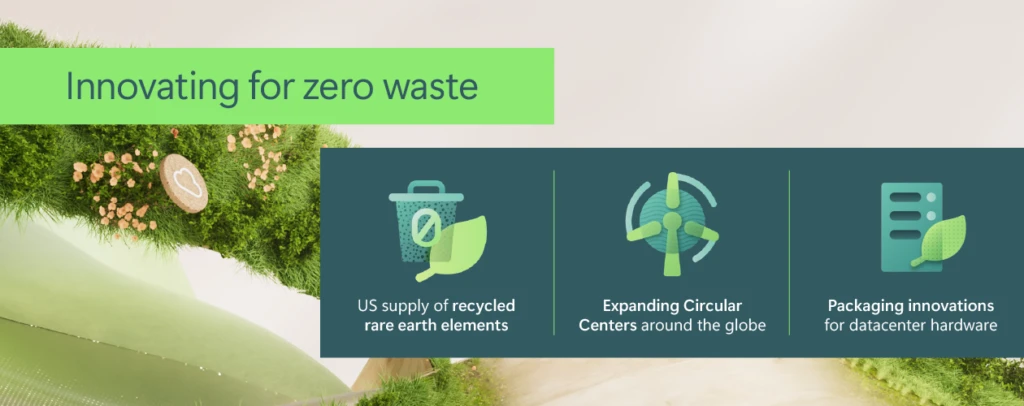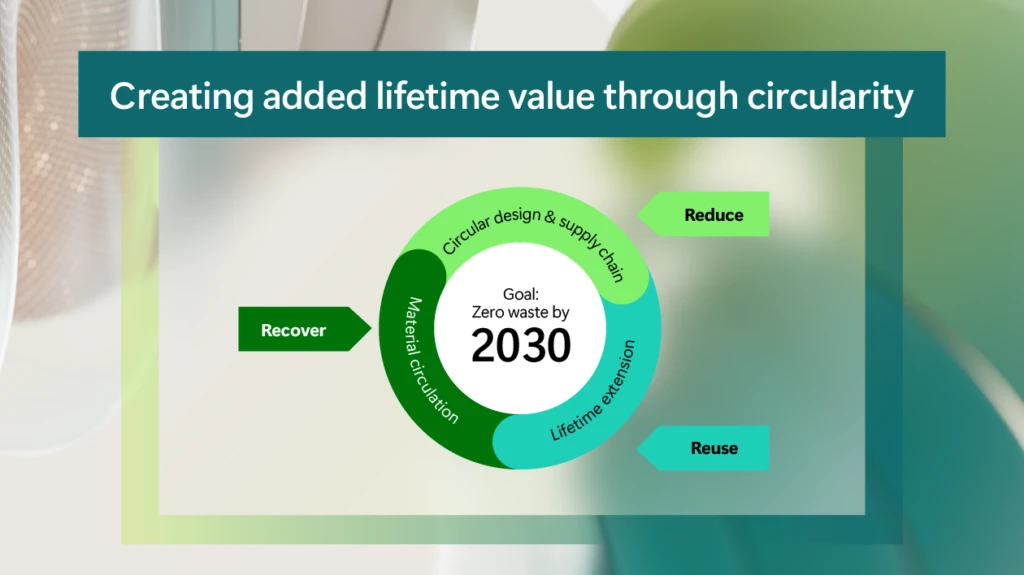
How South Korea is building an AI-powered future for everyone
At the Microsoft AI Tour in Seoul, Korean companies demonstrated how AI is moving beyond efficiency gains to become a true growth engine.

Today, we’re announcing the achievement of a significant milestone on our journey to become zero waste by 2030: we’ve reached a 90.9% reuse and recycling rate of servers and components in 2024, exceeding our 2025 target of 90% a year ahead of schedule.
Zero waste by 2030 is a cornerstone of our sustainability strategy, along with becoming carbon negative, water positive, and protecting more land than we use. This recent milestone, driven by a culture of innovation and cross-functional collaboration, reflects the growing momentum to integrate zero waste and circularity practices across the technology industry.
Working alongside our recovery partners and suppliers, we are advancing the sustainability of our cloud supply chain and driving toward our zero-waste target in three key areas: (1) piloting the sustainable extraction of rare earth minerals from hard disk drives at scale, (2) continuing to expand our Circular Centers around the world, and (3) co-creating recyclable packaging solutions for transporting datacenter hardware.

Reducing waste in Microsoft datacenters
Learn moreToday, we’re announcing a collaboration with Western Digital, Critical Materials Recycling, and PedalPoint Recycling demonstrating how we transformed approximately 50,000 pounds of end-of-life hard disk drives (HDDs) and other materials into critical, high-value materials, recovering rare earth elements (REEs) like neodymium and precious metals like gold and copper. By enabling the REE recovery process to be managed domestically, the program was designed to minimize transportation emissions and boost the resilience of the United States REE supply chain by decreasing dependence on imported materials.
When HDDs are retired from service, the data-carrying components are sanitized and shredded to ensure data security, while other components are separated in order to enable recycling and recirculation of REE materials. This initiative tackled some of the persistent technical challenges with recycling REEs: developing methods to achieve a high recovery rate for the materials, finding a recycling technique that avoids the use of harsh chemicals, and proving that the REE recycling process can be economically viable in the long term.
The innovative, acid-free dissolution of shredded HDDs delivered an impressive 90% high-yield recovery of elemental and rare-earth materials. In addition, the recycling process has an estimated 95% reduction in emissions compared to traditional mining and processing practices, based on life cycle analysis. Setting a new standard for industrial recovery of critical materials, this initiative was one of the first demonstrations of large scale, in-country recycling of essential metals and materials.
Across the company, our teams are working to improve resource efficiency and expand the lifetime value of materials through the three Rs: reduce, reuse, and recover. Within our global datacenters, our Microsoft Circular Centers are foundational to our progress, enabling us to process and route decommissioned servers and hardware components to their next useful lives, such as internal reuse, other electronic supply chains, or academies that train datacenter technicians.

By redesigning systems to reduce waste, then reusing and recovering materials wherever possible, we’re saving costs, gaining efficiency, and discovering new opportunities for hardware and infrastructure components. For example, we have successfully reused more than 3.2 million components through internal and external channels in 2024, recognizing a 30% increase or more in value recovery through our Circular Center program.
Advancing the sustainability of AI
Learn moreSince opening our first Circular Center in Amsterdam, the Netherlands, in 2020, we’ve built five additional facilities in the United States—Boydton, Virginia; Chicago, Illinois; and Quincy, Washington—as well as in Dublin, Ireland, and Singapore. To continue to connect our reuse and recycling around the globe, new Circular Centers are planned for Cardiff, Wales; New South Wales, Australia; and San Antonio, Texas.
As we build on progress over the past five years, we’re excited to continue accelerating circularity practices across our business. Preventing waste remains the core of our zero-waste strategy. In addition, we’re continuing to invest in expanding markets for circular solutions and collaborating with local organizations to support circularity in the communities where we operate and work.
In addition to advancing hardware circularity, we are also tackling the challenge of packaging for all of the hardware and components we use in our datacenters. With more than 150 original equipment manufacturers (OEMs) supplying our datacenters, solutions need to ensure the same level of protection and security for servers, racks, and components as traditional packaging methods.

One of the key challenges with packaging for the hardware and components in our datacenters is that it is typically multi-layered—for example, packaging for server racks might include a layer of wood, then glue, foam, then more wood. Because of this, the packaging was traditionally not recyclable via curbside pickup. Over the past 18 months, our Cloud Logistics team has worked with suppliers, logistics service providers, and recyclers to take those pallets and separate the layers, making the materials recyclable through local collaborations.
As a result, packaging from more than 30,000 server racks was processed through our global packaging recycling program, diverting more than 2,500 metric tons of waste from landfills. Moving forward, we are exploring the expansion of this recycling program to other types of packaging such as those used for cables, spares, and network components.
Reduce risk and improve resilience: Advancing supply chain sustainability
Learn moreBeyond recycling, our teams look for opportunities to reuse materials within the value chain to reduce the need to procure something new and enable increased waste diversion, whether for hardware, components, or packaging. For example, we are working to reduce the hard-to-recycle, plastic-based, expanded polyethylene (EPE) foam in packaging, replacing it with more sustainable paper and pulp alternatives.
Another impactful way to increase circularity in our supply chain is with innovations in packaging for our server racks. We’re currently testing reusable solutions that advance sustainability and improve business efficiency by reducing cost and providing consistency in the unpacking experience for datacenter teams, all while keeping server racks safe during transport and handling.
To learn more about Microsoft’s work to reduce waste in our datacenters, check out datacenters.microsoft.com/sustainability.
For business leaders interested in developing a circular strategy for their organization, read the whitepaper Four pillars of a successful circular datacenter hardware program with deeper insight into four essential aspects of Microsoft’s Circular Center program.